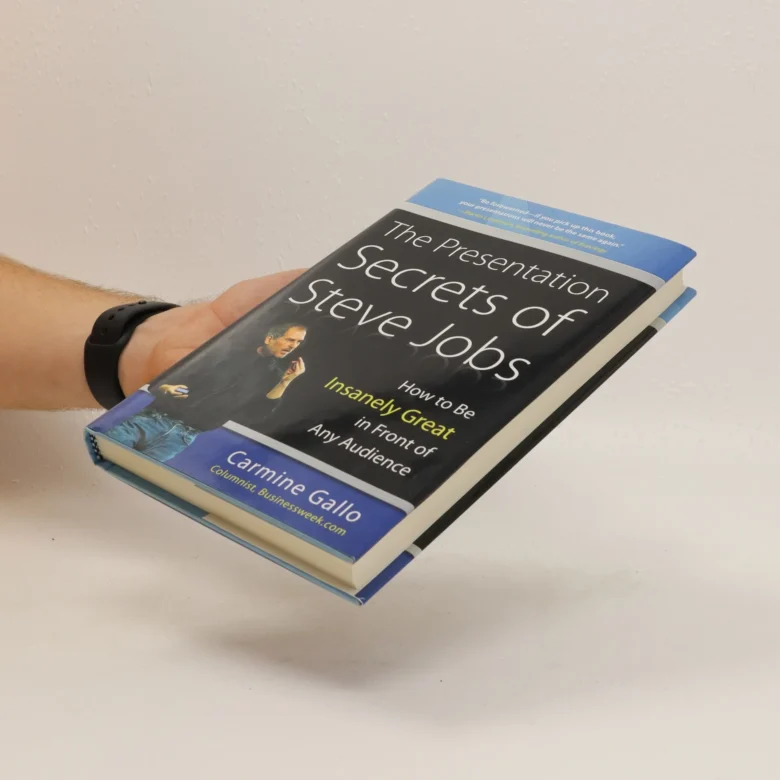When we think of legendary presentations, Steve Jobs’ name almost immediately comes to mind. Known for his captivating, innovative, and memorable product launches, Jobs had an undeniable knack for communicating complex ideas in a way that left audiences inspired and engaged. His approach was so effective that it’s become a benchmark for anyone looking to elevate their presentation skills. In The Presentation Secrets of Steve Jobs: How to Be Insanely Great in Front of Any Audience, author Carmine Gallo breaks down the techniques Jobs used to captivate, persuade, and motivate his audience, offering a roadmap to help anyone master the art of public speaking.
This book is a treasure trove for presenters, public speakers, educators, and anyone else seeking to make an impression. Below, we’ll explore some key insights and techniques from Gallo’s analysis of Jobs’ style that can help transform an average presentation into something truly memorable.
1. Create a Story
Jobs knew that a compelling narrative was at the heart of any successful presentation. Rather than merely presenting information, he crafted his presentations to follow a clear storyline with a beginning, middle, and end. This structure not only kept the audience engaged but also made the information easier to understand and remember. Gallo emphasizes the importance of building a narrative around the key points of the presentation, transforming data and information into a story that resonates.
By introducing a “hero” (the product) who faces and overcomes a challenge (a problem the product solves), Jobs created an emotional investment in the story, making the product launch more impactful. For presenters, the takeaway is to always ask, “What’s the story here?” instead of “What’s the data?”
2. Be Passionate About Your Topic
Steve Jobs’ presentations were as memorable as they were because of his obvious passion. His excitement was infectious, making even the driest of technical features sound revolutionary. Gallo explains that passion is an essential ingredient for any great presentation. If the presenter is not enthusiastic, how can they expect the audience to be? Jobs’ energy and confidence were contagious, which made his presentations magnetic.
When preparing a presentation, it’s essential to tap into what excites you about your subject. Share your passion and enthusiasm with the audience, and let it come through in your words, expressions, and body language. Audiences are more likely to stay engaged when they see the speaker is genuinely invested in the subject.
3. Keep it Simple
One of the hallmarks of Steve Jobs’ presentations was simplicity. He used very few words on his slides, relying instead on visuals that reinforced his message. In an age of information overload, less is often more. Gallo highlights that Jobs would typically use minimal text and employ high-quality images and short phrases to capture the audience’s attention without overwhelming them.
Instead of cramming slides with text, focus on the essentials. Present one idea per slide, keeping the design clean and straightforward. This helps the audience absorb the message without distraction. Gallo suggests that a slide should only be a visual aid to support your spoken words, not a script.
4. Practice, Practice, Practice
Although Steve Jobs’ presentations seemed effortless, they were far from impromptu. Behind the scenes, Jobs rehearsed meticulously. Gallo underscores that a great presentation requires a significant amount of practice, enabling the presenter to deliver confidently and smoothly. Jobs would spend hours rehearsing, refining, and perfecting his delivery, ensuring every word, gesture, and transition was on point.
The lesson here is that there’s no substitute for preparation. Practicing not only helps solidify the content in your mind but also gives you the confidence to handle unexpected situations during the presentation. Knowing your material inside and out allows you to focus on connecting with the audience rather than worrying about what comes next.
5. Focus on the Audience, Not Yourself
One of the most important principles Jobs adhered to was putting the audience first. He always asked himself how each aspect of the presentation would benefit or interest them. Gallo stresses the importance of understanding the audience’s needs, interests, and pain points. This audience-centric approach enabled Jobs to focus on the value his products would bring to people’s lives, not just the features.
Before creating a presentation, try to think from the perspective of your audience. What do they care about? How will they benefit from what you’re offering? Shifting the focus from yourself to the audience helps create a more engaging, relevant presentation that will hold their attention.
6. Create “Wow” Moments
Jobs was known for creating “wow” moments, surprising the audience with something remarkable, whether it was a new feature, an unexpected benefit, or a demo that worked seamlessly. These moments kept the audience engaged, making them feel as though they were experiencing something groundbreaking.
To incorporate this into your presentations, consider ways to surprise and delight your audience. It could be an unexpected fact, a live demonstration, or even a well-timed joke. The goal is to create memorable moments that make the presentation stand out.
7. End with a Bang
Jobs understood the importance of a strong ending. Rather than letting the presentation fizzle out, he would close with a memorable takeaway, often leaving the audience excited about what they had just seen. Gallo points out that a powerful ending reinforces the main message, giving the audience something to remember long after the presentation.
When structuring your presentation, aim to end with a key message or call-to-action that summarizes the essence of your talk. This helps the audience leave with a clear idea of what they’ve learned and why it matters.
Final Thoughts
The Presentation Secrets of Steve Jobs by Carmine Gallo is more than just a book on presentation skills; it’s a guide to becoming a more confident, compelling communicator. By adopting Jobs’ techniques—such as storytelling, simplicity, passion, and preparation—anyone can become “insanely great” in front of an audience. Whether you’re presenting a new product, teaching a class, or pitching an idea, these insights can help make your next presentation a memorable experience for your audience.




